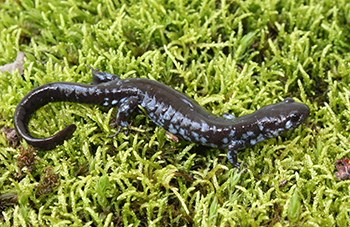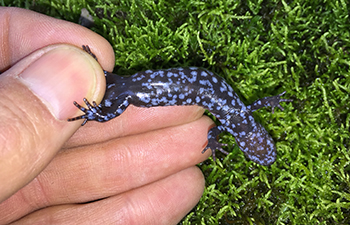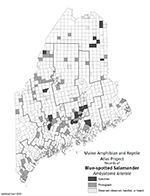Home → Fish & Wildlife → Wildlife → Species Information → Reptiles & Amphibians → Blue-spotted Salamander
Blue-spotted Salamander
Ambystoma laterale
On this page:

Photo: Trevor Persons
Distinguishing Characteristics

Photo: Trevor Persons
- Medium-sized, approximately 4 to 5 inches in length
- Dark blue to black with many small bluish-white spots, especially on sides
- Commonly confused with northern dusky salamander and "lead-backed" phase of Eastern Red-backed salamander
Status and Distribution in Maine
- Species of Greatest Conservation Need
- Uncommon
- Statewide
Habitat
- Deciduous and mixed forest
- Breeds in vernal pools, just after snowmelt in spring
- Uses burrows beneath rocks, rotting stumps and logs, moss, and debris piles
Diet
- Eats wide variety of both aquatic and terrestrial invertebrates including insects, spiders, earthworms, and snails
Seasonal Changes
- Likely hibernate in rodent burrows or other underground recesses beneath forest floor
Natural History Notes
- Populations in Maine consist of "pure" blue-spotted Salamanders, with the usual two sets of chromosomes (diploid), and hybrids of blue-spotted with Jefferson's Salamander (A. jeffersonianum; occurs south and west of Maine); hybrids often have 3, 4, or 5 sets of chromosomes
- Hybrids are usually female, and use sperm from male blue-spotted Salamanders to stimulate egg development. The sperm's genetic material is rarely incorporated, and most offspring are clones of their mother
- Pure blue-spotted salamanders are impossible to differentiate from hybrids without genetic analysis
Share Your Sighting
There is much still to learn about the distribution and ecology of Maine’s herpetofauna, and we encourage members of the public to share their photo-documented observations as part of the Maine Amphibian & Reptile Atlas Project (MARAP).
To see if a township still needs documentation of a species, consult this distribution map (PDF). If a township lacks a photo or specimen record, we want your observation!
There are two ways to share your observations:
Submit your reptile or amphibian observation online
No service? No problem. Click here to download the survey to your device while connected, then take offline to collect observations from anywhere. Tip: The survey works best on Google Chrome and Safari.
Or upload sightings to the iNaturalist citizen science project through their website at iNaturalist.org or mobile app.
- When submitting an observation through iNaturalist add a description of the location (and other noteworthy information) to the “notes” field. This serves as a check on the locations automatically generated by smartphone cameras, which may be imprecise if cell service or GPS coverage is weak.
Thank you for doing your part to help conserve Maine’s reptiles and amphibians.
